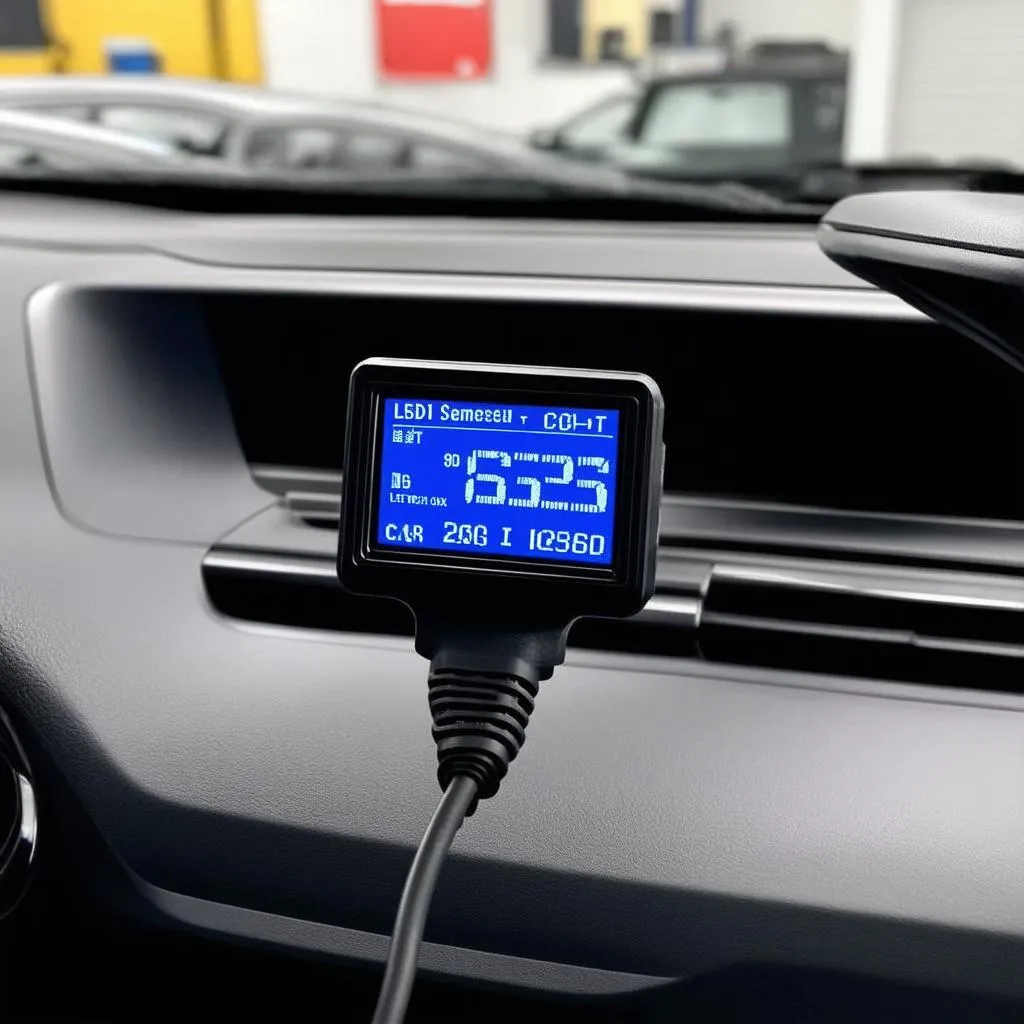“Check engine” light flashing like a disco ball? We’ve all been there. That little yellow beacon of doom can send chills down any driver’s spine. But what if you could understand what your car is trying to say instead of playing a costly guessing game at the mechanic? That’s where the magic of an Obd Lcd Display comes in.
What is an Obd Lcd Display, and Why Should You Care?
Imagine being able to read your car’s mind, understanding its every hiccup and groan. An OBD LCD display, or On-Board Diagnostics Liquid Crystal Display, is like a window into your car’s soul. It connects to your vehicle’s OBD-II port (standard on most cars since 1996) and translates those cryptic engine codes into plain English (or numbers, at least).
Think of it this way: Your car’s computer is constantly monitoring everything from engine temperature to emissions. When something’s amiss, it logs a code. A simple code reader can tell you the code, but an OBD LCD display goes a step further, often providing:
- Code definitions: No more deciphering cryptic abbreviations.
- Live data stream: Monitor engine RPM, coolant temperature, oxygen sensor readings, and more in real-time.
- Freeze frame data: Capture a snapshot of your engine’s performance right before a problem occurred.
- Troubleshooting tips: Some displays even offer potential fixes based on the code.
 OBD LCD Display Connected to Car
OBD LCD Display Connected to Car
The Power at Your Fingertips: Uses and Benefits
Whether you’re a DIY mechanic or just want to be more informed at the repair shop, an OBD LCD display can empower you. Here’s how:
1. Early Problem Detection
Just like a regular health checkup, monitoring your car’s vital signs with an OBD LCD display can help catch minor issues before they snowball into major (and expensive) headaches. For example, you might notice a slight dip in fuel efficiency or a gradual increase in engine temperature, alerting you to potential problems with your oxygen sensor or thermostat.
2. Informed Repair Decisions
Knowledge is power, especially when dealing with mechanics. An OBD LCD display arms you with the information you need to understand the problem and ask the right questions.
Scenario: Imagine your “check engine” light comes on, and the mechanic quotes you a hefty sum for a new catalytic converter. With an OBD LCD display, you might discover the issue is actually a faulty oxygen sensor— a much cheaper fix!
3. DIY Diagnostics and Repairs
For the mechanically inclined, an OBD LCD display opens up a world of DIY possibilities. Armed with the right information and a bit of know-how, you can tackle basic repairs yourself, saving time and money.
 Mechanic Using OBD LCD Display to Diagnose Car
Mechanic Using OBD LCD Display to Diagnose Car
Obd Lcd Display vs. Code Reader: What’s the Difference?
You might be thinking, “Wait, doesn’t a basic code reader do the same thing?” Not quite. Think of a code reader as a basic translator— it tells you the code but doesn’t elaborate. An OBD LCD display is like a comprehensive language guide, offering definitions, context, and even troubleshooting tips.
Beyond the Basics: Choosing the Right Obd Lcd Display
Choosing the right OBD LCD display can seem overwhelming, with options ranging from simple handheld devices to advanced models with Bluetooth connectivity and app integration. Consider your budget, technical skills, and desired features.
Key Features to Look For:
- Vehicle Compatibility: Ensure the display is compatible with your car’s make, model, and year.
- Display Size and Clarity: A clear, easy-to-read display is crucial.
- Data Parameters: Consider what data points are most important to you (e.g., RPM, coolant temperature, fuel pressure).
- Additional Features: Some displays offer advanced features like emissions readiness checks, battery voltage monitoring, and more.
Expert Insight: “Investing in a quality OBD LCD display is like having a personal mechanic on call 24/7,” says automotive expert, Dr. Emily Carter, author of “The Car Whisperer: Understanding Your Vehicle’s Language.” “It’s an invaluable tool for any car owner.”
Common Obd Lcd Display Questions Answered
Q: Will an OBD LCD display drain my car battery?
A: Most OBD LCD displays draw very little power and won’t drain your battery, especially when the engine is running.
Q: Can I install an OBD LCD display myself?
A: Absolutely! Most displays are plug-and-play, connecting easily to the OBD-II port under your dashboard.
Q: Do I need a separate display for each of my cars?
A: No, most OBD LCD displays are compatible with a wide range of vehicles.
Taking Control of Your Car’s Health
An OBD LCD display is more than just a gadget—it’s a tool that empowers you to understand and care for your vehicle. It’s like having a direct line to your car’s inner workings, allowing you to diagnose problems early, make informed repair decisions, and even tackle some repairs yourself.
Want to explore other ways to optimize your car’s performance? Check out our articles on:
Need help choosing the right OBD LCD display or setting up your diagnostic software? Our team of automotive experts is here to assist you! Contact us on Whatsapp: +84767531508 for personalized support. We’re available 24/7 to answer your questions.
Remember, a little knowledge goes a long way in the world of car maintenance. Equip yourself with the right tools and information, and you’ll be navigating those “check engine” lights with confidence.